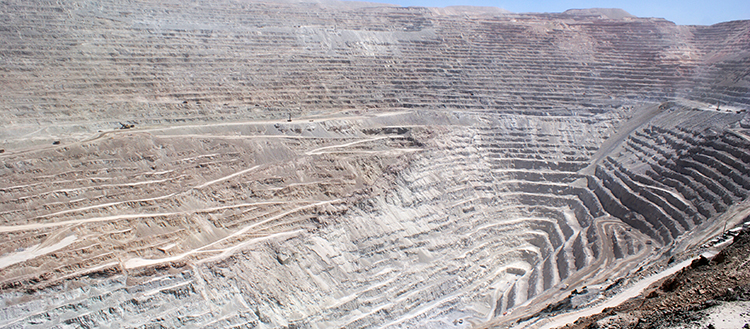Failed eruptions are at the origin of copper deposits
UNIGE scientists reveal a surprising mechanism in the formation of copper deposits, an essential metal for the energy transition.

The Chuquicamata open pit mine (Chile) exploits one of the largest porphyry copper deposits in the world: it is 4.3 km long, 3 km wide and up to 0.9 km depth. (c) Massimo Chiaradia
Copper is one of the most widely used metals on the planet today due to its electrical and thermal conduction properties. The greatest natural resources of this metal are the so-called “porphyry” deposits that come from magmas deep in the Earth. In a recent research, scientists from the University of Geneva (UNIGE) demonstrate that these deposits are largely produced by mechanisms similar to those causing large volcanic eruptions. At a time when current copper resources are dwindling and this metal plays a key role in the energy transition, this discovery opens up new avenues for the development of tools to find new deposits. These results can be read in the journal Nature - Communications Earth & Environment.
Copper is one of the most exploited natural resources on the planet. An excellent conductor and highly resistant to corrosion, it is used to produce all types of wires and electrical connectors. It is also used to make many alloys, such as bronze and brass. Considered an essential material for the energy transition - it is massively used to equip electric cars - its demand will exceed the resources currently available within a few decades. Discovering new deposits and acquiring new knowledge about their formation is therefore a crucial challenge.
Research led by Massimo Chiaradia, senior lecturer at the Department of Earth and Environmental Sciences at the UNIGE Faculty of Science, has made an important discovery in this field. It highlights the fact that the “porphyry” deposits - named after a magmatic rock that contains copper - are the result of mechanisms very similar to those that cause large volcanic eruptions. “We have discovered that large reserves of copper are born of failed eruptions,” explains the researcher.
From the magma
Copper comes from hot fluids, mostly composed of water, released by cooling magmas. These magmas, which are also the basis of eruptions, come from the intermediate layer between the core and the crust of the Earth, known as the “mantle”, and then rise to the surface of the Earth where they form a “magma chamber”. This chamber is generally located between 5km and 15km depth. “If the volume and speed of magma injection into this reservoir is very large, a large quantity of fluids can be emitted catastrophically into the atmosphere with the magma during a volcanic eruption,” explains Massimo Chiaradia, first author of the research. But these fluids can also develop in a quieter way under the earth’s surface and give rise to a porphyry copper deposit at a depth varying between 1km and 6km.
However, this phenomenon is much less frequent, which partly explains the rarity of copper deposits. “It takes tens to hundreds of thousands of years for a copper deposit to form, whereas volcanic eruptions are more frequent. A failed eruption depends on the combination of several parameters: the speed of magma injection, the speed of its cooling and the rigidity of the earth’s crust that surrounds the magma chamber. The latter must be flexible to absorb the pressure exerted by the new magma arrivals, so that the eruption does not take place,” explains Luca Caricchi, second author and associate professor at the Department of Earth and Environmental Sciences.
Useful for future deposit exploration
“The discovery of similarities between large eruptions and deposits will make it possible to use a large amount of knowledge acquired by vulcanologists to advance our understanding of the formation of porphyry deposits,” says Massimo Chiaradia. To reach their results, the UNIGE scientists relied on data and figures provided by the mining companies and on those collected in the field and in the laboratory by numerous researchers - combined with petrological and geochemical models.
These discoveries open new avenues for the development of geological, mineralogical and geochemical tools for future successful exploration of the largest porphyry copper deposits on Earth. “The next step will be to work on a model that will help us to quantify the total copper content and therefore the quality of a potentially exploitable deposit as accurately as possible,” concludes Massimo Chiaradia.
